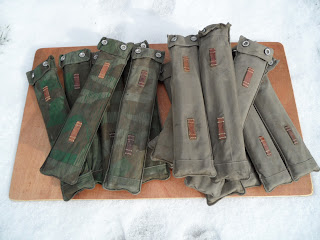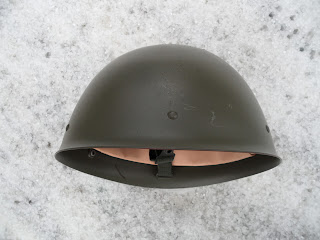I have another batch of Swiss Zelt - Tent bags with poles and stakes that I just picked up. 15 more to be exact!
This batch has a total of 6 bags in splinter camo pattern, and 9 bags in plain field gray. Each set includes 3 wooden poles with aluminum sockets and galvanized steel tent stakes. All of the bags date to the 1940's and 1930's, with the newest one dated 1944. Many of the tent stakes are dated and have dates from the 1940's , 1930's and a few from the 1920's. The stakes were hot-dipped galvanized, and as such, the galvanization layer is quite thick and has filled in many of the lighter date stamps on many of the stakes.
Here are some close up photos of the bag dates:
Here are some close ups of the steel tent stake dates:
Two of the stakes in this batch are actually made out of aluminum and are from the tent sets that were issued with the Alpenflage patterned Zelts that were manufactured later (I believe that these aluminum pole and stake sets were manufactured in the 1980's, but I'm not sure). Here is a shot of the aluminum stakes followed by an archive photo of an Alpenfage tent pole set:
Each set includes three poles that measure approximately 16 inches long, with a total length of about 44 1/8 inches long when all assembled. Here is a couple of photos of the poles:
It is interesting to note that the Swiss splinter camo, Zelteinheiten 1901 Pattern, is nearly identical to the WW2 German Wehrmacht Splittertarn camo (splinter). The only difference is in a very small detail. If you look very close at the Swiss camo pattern, you will notice that there is a thin green line that connects the dark green portion to the lighter green area. These thin green lines are not present on the German pattern. It has often been speculated, but never confirmed, that Switzerland secretly manufactured a large amount of military gear for Nazi Germany and at the same time, copied the German camo pattern with a small detail change for their own troops. Very interesting........ Here are a couple of close up shots of the Swiss camo pattern on these bags. If you look close, you can see the "thin green line" that connects the dark green to the light green (it shows good in the lower left bag):
Thursday, February 24, 2011
Tuesday, February 22, 2011
Svenska M 37 Stålhjälm, Swedish M 37 Steel Helmet M37/65
Our showcased item for today is a new Swedish helmet that I just picked up. In fact the helmet arrived just in time for some new snow here in Port Townsend! Now how appropriate is that?
The helmet is a brand-new condition, looks-unissued, Swedish Model 1937 (M 37), helmet. Most of the original M 37 helmets that were made in 1937, were refurbished and a newer suspension headliner installed in the 1960's and 1970's. At the time these helmets were first refurbished, they were given a new model designator of M37/65. I'm not sure if that would mean that this helmet is a M37/73 ??? This helmet is marked with the painted date stamp of "73" for the year 1973 (it looks brand new, but all of the info I have found indicates that this is the refurbish date, not a manufacture date). It is also stamped with "AL-E" above the 73, which I believe indicates the unit or branch of service, but I'm not positive........ still researching that. The shell size is a 69, which is the the "average" sized shell with an adjustable liner that fits from sizes 55-59. The actual designation for this new style liner is "liner model 3", or "Mod. 3". The helmet shells were manufactured in the following sizes: 66, 69, 72, and 75. The adjustable head band portion of the liner actually looks exactly like the adjustable liner band on my post-war BGS helmet. This leads me to believe that the liners in these refurbished Swedish helmets may actually be a German manufactured liner. I'm not sure on that though, I'm still researching that fact.
The model 37 helmet was in use until the modern kevlar M90 helmets were issued to the troops in 1993 to 1994. In the 1990's the Swedish government supplied the new Estonian Army with M37 helmets. I would guess that with all of the "old" M 37 helmets that had been pulled out of service, that there was plenty of old stock to send their way.
Here are some close up pictures of my Swedish helmet:
Here are a few historical shots:
 |
| Estonian Troops in the 1990's in Swedish Helmets |
 |
| Swedish Troops in WW2 (M37 helmets with original liners) |
1963 Popular Boating Magazine and Boating Advertisements
 |
| Cris Craft Boats 1963 |
 |
| Owens Boats 1963 |
 |
| Starcraft Boats 1963 |
 |
| Century Boats 1963 |
 |
| Traveler Boats 1963 |
 |
| Trojan Boats 1963 |
 |
| Aristo-Craft Boats 1963 |
 |
| Cutter Boats 1963 |
 |
| MFG Boats 1963 |
 |
| Pacemaker Boats 1963 |
 |
| Pearson Boats 1963 |
There are even a couple of pretty good outboard motor ads....... plus a ton of other advertisements that I will still need to get around to scanning into my archives.
 |
| Homelite Boat Motors 1963 |
 |
| Johnson Boat Motors 1963 |
Friday, February 18, 2011
U.S. Military Shoulder Patches of the United States Armed Forces
I picked up a fantastic reference book yesterday while I was down on Water Street at the William James Bookseller book store trading in some books for credit. (There goes the credit!).
This book is a pre-internet reference book of all the US military shoulder patches used from WW1 through the 1970's, and includes not only the military, but also R.O.T.C., Civil Air Patrol, and NASA patches. It is laid out in a great format with glossy group photos of actual patches and a list below the photo to identify them. The book is spiral bound and published by the small independent publisher of M.C.N. Press of Tulsa, Oklahoma. The book was written by Jack Britton and George Washington Jr..
I have found the internet to be one of the most amazing research resources ever, and it has enabled me to learn about, document, and research so many of the items in my collection, but I have discovered that it does have its limitations when trying to identify an unknown patch, button, pin, etc. With a printed book like this patch book, I can just flip through the pages, and scan the photos, until I spot the patch......... then I can go to the internet and find more in depth information on the item. A book like this is like a locksmith's book of key codes. Once you have the code, you can unlock the vault. In this case the vault is the internet, and the "codes" let me find and access the addresses!
I would highly recommend this book and I noticed that copies are available on Amazon.com and most likely on eBay as well. Now I'm inspired to start digging out that pile of old patches and see what I can identify! Stay tuned..........
U.S. Military Shoulder Patches of the United States Armed Forces 3rd Edition, copyright 1981.
This book is a pre-internet reference book of all the US military shoulder patches used from WW1 through the 1970's, and includes not only the military, but also R.O.T.C., Civil Air Patrol, and NASA patches. It is laid out in a great format with glossy group photos of actual patches and a list below the photo to identify them. The book is spiral bound and published by the small independent publisher of M.C.N. Press of Tulsa, Oklahoma. The book was written by Jack Britton and George Washington Jr..
I have found the internet to be one of the most amazing research resources ever, and it has enabled me to learn about, document, and research so many of the items in my collection, but I have discovered that it does have its limitations when trying to identify an unknown patch, button, pin, etc. With a printed book like this patch book, I can just flip through the pages, and scan the photos, until I spot the patch......... then I can go to the internet and find more in depth information on the item. A book like this is like a locksmith's book of key codes. Once you have the code, you can unlock the vault. In this case the vault is the internet, and the "codes" let me find and access the addresses!
I would highly recommend this book and I noticed that copies are available on Amazon.com and most likely on eBay as well. Now I'm inspired to start digging out that pile of old patches and see what I can identify! Stay tuned..........
Wednesday, February 16, 2011
Model 1917 Remington Bayonet
Today's post is on a WW1 vintage bayonet that I picked up at a garage sale near Portland, Oregon about 30 years ago. The bayonet is a Remington Model 1917 manufactured for the Model 1917 Rifle, officially designated as the "United States Rifle, Caliber of .30, Model of 1917". When I originally purchased the bayonet, it was still packed in cosmoline grease and wrapped in the original grease coated paper.
These bayonets were manufactured by the Remington and Winchester firearms companies of the United States (Each manufacturer stamped their own name on the blade. Mine is a Remington). This model of bayonet and the Model 1917 rifle saw service all through WW1 and even during early WW2 with some of the US troops in the South Pacific. After the Model 1917 rifle was replaced, these bayonets continued to be issued with the Winchester Model 1897 Trench Shotgun. The shotgun was standard US military issue all through WW1, WW2, and the Vietnam War. In the 1920's and 1930's, a number of shotguns were sold to various US police and sheriff's departments. I'm not sure if the bayonets were sold with the shotguns though.
This bayonet was very similar to the British Pattern 1907 Bayonet, so it was decided to mark the Model 1917 bayonet with two distinctive vertical grooves on the wooden grips to uniquely distinguish it.
Here's a few pictures of my bayonet. Unfortunately I do not have a scabbard for it....... I'm still looking.
And as usual, here are a couple of historic shots:
Subscribe to:
Comments (Atom)











































